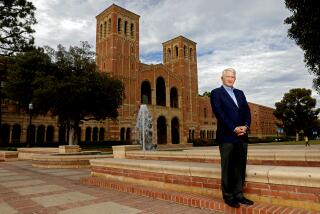His stunts drive Web traffic
Race car driver Ken Block speeds down a narrow band of asphalt in his souped-up Ford Fiesta, careening through the “Back to the Future” set on Universal Studios’ back lot.
The speedometer flies toward 80. Block’s eyes are fixed on the road as he accelerates toward an invitation-only crowd of gear heads in town for the Los Angeles Auto Show.
When he whips around the corner toward Courthouse Square in Marty McFly’s hometown, Block sees a sea of undistinguishable faces. He plants his foot on the accelerator, then pulls back on a massive hand brake on his right side.
Instantly, the rear wheels skid and Block muscles the car into a tight circle. The car spins once, then twice, in a succession of doughnuts. The pungent smell of burning rubber fills the air as clouds of blue smoke billow off the tires.
After the third spin, Block wrestles the race car free of the tight turn. He steers toward the wide-eyed crowd that inches forward for a closer look.
Block zooms past and circles the set another time. He ends the routine with a sweeping drift that brings the car within four feet of the crowd before shuddering to a stop.
The growling engine quiets as the crowd applauds. Before stepping out to meet his fans, Block jerks off his helmet and replaces it with a black baseball cap.
“How are you guys doing?” Block asks, as if nothing had happened.
There’s small talk, a few photos, autographs and the obligatory promotion for the Fiesta idling behind him. Ford was the sponsor of the event. For Block, this is more than just a performance; it’s his job.
An athletic 45-year-old adrenaline junkie, Block has parlayed his doughnut-carving skills into a lucrative business. His YouTube videos have become Internet sensations, drawing advertisers such as Ford and energy drink company Monster.
His talents have turned him into a motor star for a new generation, unlike NASCAR drivers who appeal to a different, if not older, crowd. Millions of viewers have posted Block’s short films on their Facebook and Twitter accounts. According to Mashable, a social media news website, two of Block’s videos are among the four most shared advertisements in the world.
In one video, Block can be seen speeding down an empty Oakland Bay Bridge, ripping a set of tire-smoking doughnuts between two trolley cars, and seemingly breaking the laws of physics by twisting the car in mid-flight on a 90-degree turn after jumping a hill.
Within 24 hours, the video was viewed more than 5 million times.
•
Block’s routine is called “gymkhana,” and it has more in common with board sports than car races. Instead of competing for a good lap time, Block is trying to perform a set of uniquely choreographed maneuvers on an open course much in the same way that he tried to pull off tricks on a skateboard when he was younger.
Growing up in Long Beach in the 1970s, Block often tagged along with his brothers as they got involved in the emerging skateboard scene. When he was 10, his older brother bought him a skinny wooden board with fat wheels.
Almost immediately, Block began practicing at skate parks in Long Beach and Lakewood. He was hooked and began diversifying his skills. He raced amateur motocross until he was 17. He snowboarded the jumps, half pipes and rails at Mammoth Mountain.
As he got older, Block realized he didn’t have the talent to become a professional. While attending Palomar College, he learned graphics design and screen printing and designed T-shirts that he was able to sell to local skate shops.
After talking his parents into a $10,000 loan, he started a small business in 1991 with friend Damon Way. The company, Eight Ball, specialized in simple, mostly monochromatic apparel and used an advertising campaign that pictured friends, including superstar skateboarders Rob Dyrdek and Damon’s brother Danny Way, wearing the clothing line.
The clothes had an urban feeling yet were functional for skaters. The shoes used non-slip material on the soles and laces that couldn’t come undone. The shoe line ultimately became known as DC Shoes.
By the late 1990s, skateboarding and other action sports had gone mainstream, opening up a larger market for the company. In addition, DC’s styles were popularized by rap-rock bands such as Limp Bizkit and Cypress Hill. In 2003, the company had revenue of about $100 million. A year later he sold DC to Quiksilver Inc. for $87 million.
Block still works in brand marketing for the company. He also moved to Park City, Utah — where he lives with his wife, Lucy, and three children — to have easier access to the ski slopes for snowboarding and downhill mountain biking.
He also became obsessed with racing rally cars, a closed- or open-course competition with hairpin turns, hills and jumps. Like the sports of his youth, rally racing balanced danger and talent.
It didn’t take long for Block to become hooked and in time become an action sports athlete himself, much like those he approached years earlier to market his sports gear.
•
Block learned his driving skills sliding around the tarmac at the former El Toro Marine Corps Air Station.
He competed in a gymkhana event on an obstacle course that required drifting around an array of obstacles within a time limit and performing 360-degree spins and figure eights. In order to improve his technique, he began recording his practice runs on video.
“We just filmed one day when I was learning to develop my skills as a driver. You know, fooling around and stuff,” Block said. “Well, we put the footage online not thinking anything of it, and within a week, it had a couple hundred thousand views.”
His first professionally produced video, “Gymkhana Practice,” filmed at the El Toro airfield, was a hit. In the second video, “Gymkhana 2,” filmed on the docks at the Port of Long Beach, Block began decking out his car with logos of DC Shoes and other sponsors, and his business was born. He’s since made three more videos, each one becoming more intricate and choreographed than the last.
The third was filmed just south of Paris at an oval track with 51-degree wall banks where Block performed his signature doughnuts. The fourth was on the Universal Studios back lot and involved studio props, a Bollywood dance troupe and the shark from “Jaws.”
His most recent video is a wild ride on the streets of San Francisco that makes Steve McQueen’s roadwork in “Bullitt” look amateurish. To capture the footage, Block hired a team of about 70 and used 10 cameras.
Block’s five gymkhana videos have had more than 200 million views on YouTube. Their success has given him a fan base that extends to his racing career, but it has also drawn critics, who have posted snarky comments on YouTube videos of his crashes. In various chat rooms, he is dismissed for being more of an entertainer and marketer than a sportsman.
“The purists might not understand, but these days, every successful race car driver has to have a little P.T. Barnum in them,” said Ralph Sheheen, a lap-by-lap race announcer for auto sports channel Speed. “The real fuel in auto racing is money, and Ken Block brings that in for his sponsors. When he makes a video, it spreads like wildfire.”
Jamie Allison, director of Ford’s racing division, said Block was the perfect person to market the Fiesta, a front-wheel-drive subcompact car, to a younger crowd. His work behind the wheel, Allison said, has gained traction with a teenage and millennial crowd more inclined to watch a 10-minute stunt video than a three-hour track race.
“Ken can help us connect with a new generation of fans and enthusiasts,” Allison said. “We have seen a disengagement in the next generation of drivers. The number of driver’s licenses among young people has dropped. Meanwhile, we have seen a consistent increase in the number of young people in action sports.
The Federal Highway Administration confirms the trend: Fewer licenses are being issued, and fewer miles are being logged among drivers ages 34 and younger.
Block is aware of the crowd he needs to appeal to. “I’m a dude in his mid-40s, who acts likes he’s in his 20s,” he said. “But I don’t plan on stopping any time soon.”







